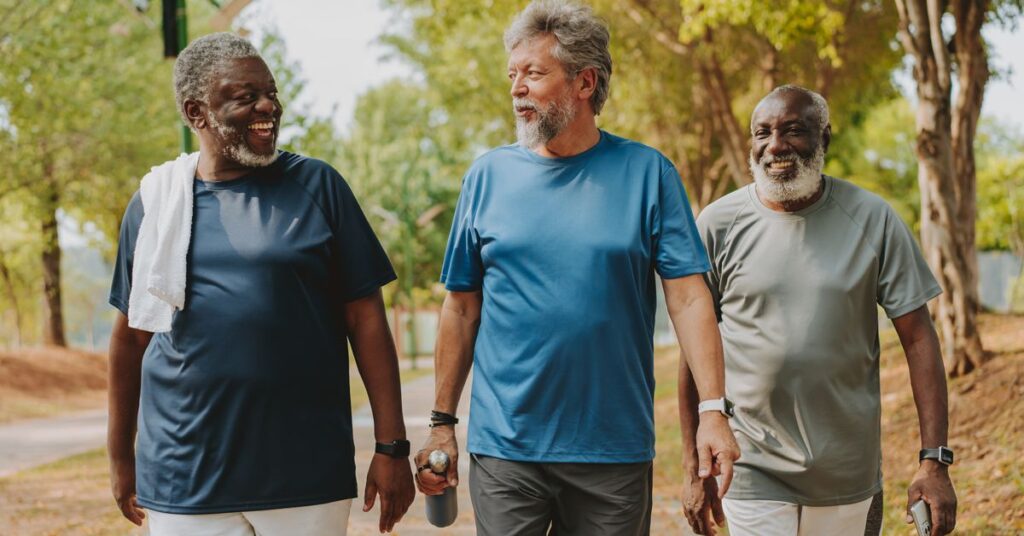- A new study finds that short bouts of daily brisk walking are linked to a significantly lower risk of death.
- The research underscores the importance of intensity, not just duration, during daily physical activity.
- The study is the first to observe these health benefits in low-income, predominantly Black communities.
Walking briskly for just 15 minutes a day is linked to a significantly lower risk of death than walking slowly, even for a much longer time.
The findings may have important implications for underserved communities.
It’s the first study to examine the health effects of walking pace in predominantly low-income and Black communities. The researchers said these communities often face economic barriers and are more likely to live in impoverished areas with little access to safe walking spaces.
Wei Zheng, MD, PhD, MPH, the study’s senior author and director of the Vanderbilt Epidemiology Center, told Healthline that the link between brisk daily walking and lower mortality risk isn’t surprising. What’s notable, he said, is that the benefit remains strong in communities that are typically underrepresented in research.
Most previous studies have focused on white, middle- and upper-income populations.
Short bouts of brisk walking could offer an accessible way for people in underserved communities to improve their health — it’s low-cost, easy to do, and time-efficient.
Zheng added that many people in these communities may not be able to afford a gym membership or may have a limited amount of leisure time for physical activity.
“If they can do some intensive walking, it will have a beneficial effect. One of the reasons we looked at it is because, regardless of age and fitness level, it’s something most people can do,” Zheng said.
Zheng and his team examined the relationship between walking pace and death rates in 85,000 people enrolled in the Southern Community Cohort Study. Most participants were low-income and Black, recruited from 12 southeastern U.S. states. About half of them reported earning less than $15,000 per year.
Walking pace and duration were reported separately from other leisure-time physical activities. They were asked to estimate how many minutes per day they spent “walking slowly” (for example, moving around the house or walking the dog) or “walking fast” (such as climbing stairs or walking briskly).
Over a 17-year follow-up period, 26,862 participants in the cohort died. When researchers compared reported walking patterns with mortality, they found that those who walked briskly for at least 15 minutes a day had nearly a 20% lower risk of death.
Slow walking offered a modest benefit — a 4% reduction in mortality risk — but it required a significantly longer duration: more than three hours per day.
The protective effect of walking was more strongly associated with a reduced number of deaths from cardiovascular disease compared to deaths from cancer. People with preexisting conditions — such as obesity or diabetes — saw even greater reductions in risk than healthier participants.
“This study puts further emphasis on fast-paced walking as a viable strategy to address existing health disparities and lower the risk of cardiovascular disease, particularly in low-income and Black populations, which see disproportionate rates of heart disease,” said Lu Qi, MD, PhD, HCA Regents Distinguished Chair and professor of epidemiology in the Celia Scott Weatherhead School of Public Health and Tropical Medicine at Tulane University. Qi wasn’t involved in the research.
Current guidelines recommend that adults get at least 150 minutes of moderate-intensity physical activity per week. Brisk walking, as long as the pace is vigorous enough, can help you meet that goal.
Walking the dog or taking a leisurely stroll may not be enough to reach the moderate-intensity threshold.
In recent years, both the medical and fitness communities have shown growing interest in the health benefits of higher-intensity exercise. In the gym, this might include HIIT workouts, while walking can be intensified with techniques like interval walking or “Japanese walking.”
“While any activity is good, higher-quality activity can really pack a more powerful punch,” said Sarah F. Eby, MD, PhD, a sports medicine specialist at Mass General Brigham Sports Medicine and assistant professor of physical medicine and rehabilitation at Harvard Medical School.
Workout intensity is subjective, but the goal of interval training is simple and widely applicable: alternate periods of higher intensity with periods of lower intensity. During a walk, this could mean switching between a slower pace and a brisk one, using your breathing as a guide to intensity.
Zheng encourages everyone to “be mindful” of their pace when they are out walking to ensure they are getting a little extra intensity.
“We walk all the time from one place to another. Increasing our pace and walking briskly during those periods not only saves time but it also offers these health benefits,” he said.
However, even though walking is generally accessible, there may still be accessibility issues for some.
“The barriers to entry aren’t zero. Unfortunately, folks with lower income levels tend to have less flexibility with work schedules and often live in more polluted areas that lack adequate, safe, walking infrastructure,” said Eby.
She points out that there may still be opportunities for safe walking environments through participation in walking clubs or local community centers. Eby said she’s even had patients tell her about doing laps in their own homes by planning indoor walking paths.
“The significant mortality benefit from regular walking demonstrated by this study highlights the need for investment in safe walkable infrastructure and considerations for workplace interventions to allow for brisk walking breaks, if even for just 15 minutes a day,” she said.
Source link : https://www.healthline.com/health-news/brisk-walking-may-lower-cardiovascular-disease-risk
Author :
Publish date : 2025-08-02 07:17:00
Copyright for syndicated content belongs to the linked Source.
